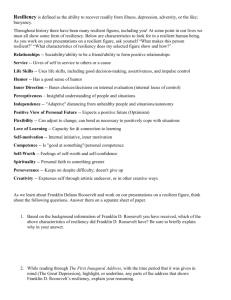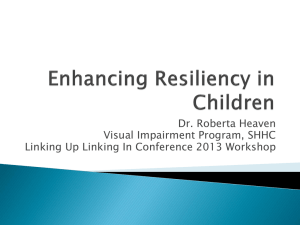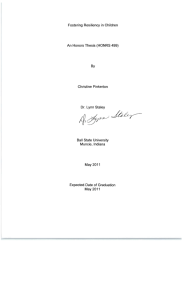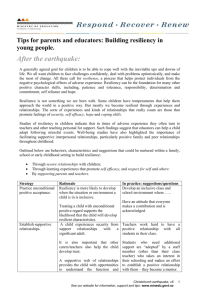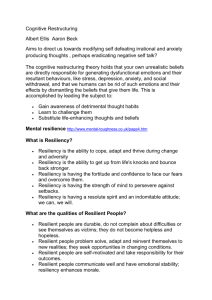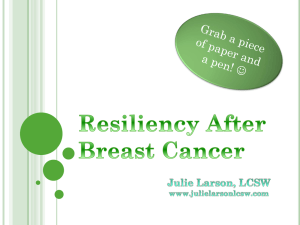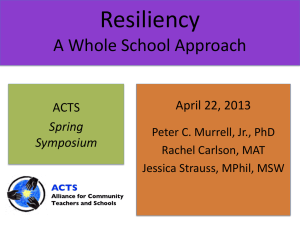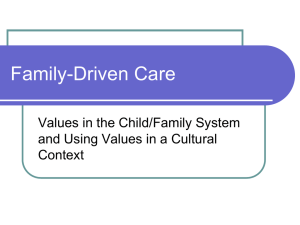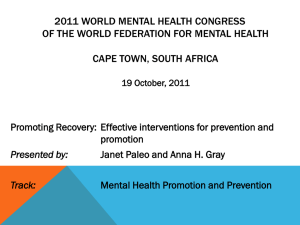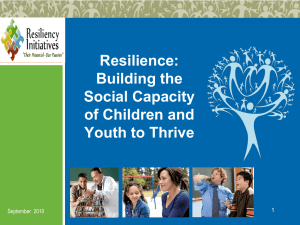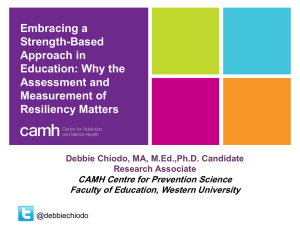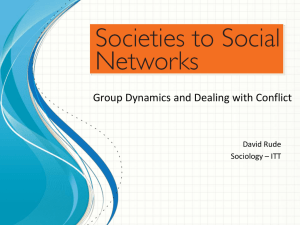Resiliency in Action
advertisement
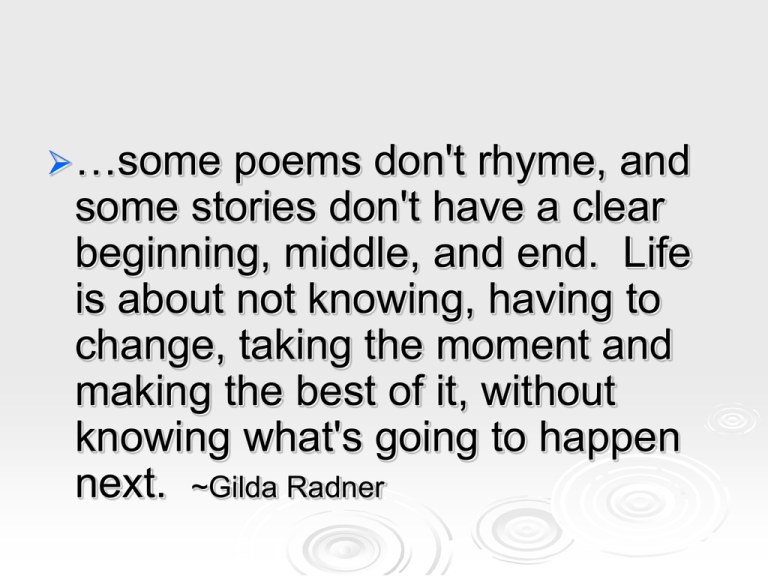
…some poems don't rhyme, and some stories don't have a clear beginning, middle, and end. Life is about not knowing, having to change, taking the moment and making the best of it, without knowing what's going to happen next. ~Gilda Radner Perhaps someone bound for greatness is sitting in one of our classes… Agatha Christie had a writing disability so severe that she had to dictate her mystery novels to others to type. Michael Jordan was cut from his high school basketball team. Winston Churchill failed a grade in elementary school. Werner Von Braun flunked ninth grade algebra. Fostering ResiliencyFoundation for Success May 26, 2010 Maureen Siwik, Joanne Oxenford Linda Feldstein, Marilee Cassidy A bit of background… 2007—Pupil Services Annual Conference 2007-08—colloquium: Resiliency in Action, Nan Henderson 2008—Student Services Symposium 2008-09—colloquium: The Resilience Revolution, Larry Brendtro & Scott Larson 2009—PSCA conference 2009—Student Services Symposium 2009-10—Promoting Student Success through Resiliency, PDE online course Focus Definition of resiliency Importance of a resiliency focus Creating a culture of resilience Administrative role Reframing our thinking: from ‘fluff’ to FOUNDATION The Deal of Your Life Diamonds=Money/Income Clubs=Social Life/Friends Spades=Education/School Hearts=Family/Support Group according to suit; rank order the of importance of each suit. Share your hand and discuss: 1. 2. 3. Were you dealt a balanced life? What cards would help you increase the balance of your life? What cards are not helping you? Determine the positive and negative factors associated with the “hand you were dealt.” 1. 2. 3. What’s missing? What is there too much of? What are the consequences of imbalance? Protective factors Nan Henderson’s definition: Qualities within an individual and environmental supports that help an individual bounce back from adversity. Internal – Individual personality attributes or dispositions Environmental – Resiliency builders in family, school, community, peer groups Internal Protective Factors Relationships – Ability to be a friend & to form positive relationships Service – Gives of self in service to others and/or a cause Humor – Has a good sense of humor Inner Direction – Bases choices/decisions on internal evaluation Perceptiveness – Insightful understanding of people and situations Independence – “Adaptive” distancing from unhealthy people and situations Positive View of Personal Future – Expects a positive future Flexibility – Can adjust to change Love of Learning – Capacity for and connection to learning Self-motivation – Internal initiative and positive motivation Competence – Is good at something Self-Worth – Self-confidence Spirituality – Personal faith in something greater Perseverance – Doesn’t give up Creativity – Uses creative imagination, thinking, or other processes From Nan Henderson presentation, PSEA Dept. of Pupil Services Annual Conference, August 2007 Environmental Protective Factors Promotes close bonds Values and encourages education Uses high warmth/low criticism style of interaction Sets and enforces clear boundaries (rules, etc.) Encourages supportive relationships with many caring others Promotes sharing of responsibilities, service to others Provides access to resources for meeting basic needs of housing, employment, health care, etc. Expresses high, and realistic, expectations for success Encourages goal-setting and mastery Encourages pro-social development of values and life skills Provides leadership, decision-making, and other opportunities for meaningful participation Appreciates, develops, and offers opportunity to share the unique talents of each individual From Nan Henderson presentation, PSEA Dept. of Pupil Services Annual Conference, August 2007 KEY PRINCIPLES OF THE RESILIENT SCHOOL Caring High and Support Expectations Youth Participation and Involvement “Fostering Resiliency in Kids: Protective Factors in the Family, School and Community” Bonnie Bernard, August 1991 Search Institute 40 Developmental Assets External 40 Assets & Internal Assets opportunities, skills, relationships, values and self-perceptions that all young people need to succeed. Resilient Person Researchers Werner and Smith developed a simple way to define a resilient person. They say that a resilient person loves well, works well, plays well, and expects well. What they mean is that resilient people have some loving/caring relationships in their lives, are successfully working on a job or in school, have fun (play) utilizing hobbies and positive leisuretime interests, and expect a positive future for their lives. Resiliency Quiz Are you a resilient person? What conditions in your life have helped you to be resilient? What internal qualities have helped you to deal with major stressors? PA Dept of Education defines resiliency as… The capacity to overcome risk factors to move toward positive development (Bernard, 2004) To spring back , rebound, and successfully adapt in the face of adversity (Henderson and Milstein, 2003) The PDE Resiliency Wheel High Expectations Unconditional Support Clear and Consistent Boundaries Meaningful Student Engagement Strong Results for Students Connectedness & Bonding Skills for Life Here’s what the research tells us… A protective factor is a process that interacts with a risk factor in reducing the probability of a negative outcome. (Brook, Nomura, & Cohen, 1989; Cowen and Work, 1988; Werner & Smith, 1989) The Power of Assets to Protect 0–10 Assets 11–20 Assets 21–30 Assets 31–40 Assets 61% 48% 42% 38% 32% 25% 22% 21% 19% 14% 11% 3% 5% 7% 7% 2% Sexual Intercourse Depression/Suicide Anti-Social Behavior Violence The Power of Assets to Prevent 49% 0–10 Assets 11–20 Assets 21–30 Assets 31–40 Assets 39% 35% 31% 27% 19% 18% 14% 11% 3% Alcohol Use 9% 4% 1% Tobacco Use 6% 1% Illicit Drug Use 3% Driving and Alcohol Werner and Smith comment, “Buffers (protective factors) make a more profound impact on the life course of children who grow up under adverse conditions than do specific risk factors of stressful life events. The also appear to transcend ethnic, social class, geographical, and historic boundaries. (1996, p. 202) The Power of Assets to Protect for All Kids Number of Assets 30 American Indian Asian American African American Latino/Latina White Multiracial 25 20 15 10 5 0 1 2 3 4 5 6 7 8 9 Number of High-Risk Behaviors 10 “Intentional efforts to change contexts to improve developmental success among young people can work. Researchers consistently find that a cluster of intervention components makes a difference.” (Benson et al, 2006) The Power of Assets to Promote 89% 88% 0–10 Assets 11–20 Assets 21–30 Assets 31–40 Assets 85% 77% 74% 69% 65% 57% 47% 47% 50% 36% 30% 26% 17% 8% Succeeds in School Values Diversity Maintains Good Health Exhibits Leadership Rutter (1987) suggests that schools can be protective because they can promote selfesteem and self-efficacy by providing opportunities for students to experience success and enabling them to develop important social and problem solving skills. http://www.pdesas.org/default.aspx Strengths based approach Resiliency Immersion- mindset, attitude, empowering. Explicit Instruction - identify strengths. Patience up! – focus on the positive, don’t give Who and what made me resilient? Who and what made me resilient? How did they do it? Who and what keeps me resilient now? How? Resiliency Blizzard On paper write what you would like to receive more often that would help you feel more resilient. Crumple the paper and toss into the basket as it’s passed from table to table. Pick a paper that is not your own and read it to the group. Are there common themes? Change the Culture Power Use of one person resiliency resources School Connectedness is key What can we learn from studies on school violence? Margaret Mary Kerr, UPMC Star Center Link, Jan. 2002 “Adolescents who feel closely connected to their school …are emotionally healthier, and far less likely to engage in risky behavior than their counterparts who feel no sense of community in their school…it is the formation of friendship networks within the school that help to provide that sense of community, along with the perception that teachers care, that teachers are fair, and that school is a place where one belongs.” (Resnick, 1999) Implication for schools: Create schools where no student is anonymous. “In well over ¾ of incidents, the attackers had difficulty coping with a major change to a significant relationship or a loss of status (e.g., a personal failure), prior to their school attack.” Implication for schools: Implement programs that foster resilience. Caring relationships Opportunities for students to participate High expectations Tools (there’s an app for that…) Save Your Voice for Teaching Tools & Tips for Fostering Resiliency in your School “Checklist for Turnaround Teachers” Bully-prevention brochures What can I do to foster resiliency in my building? Start with what is right rather than what is acceptable. ~Peter F. Drucker “A Checklist for Turnaround Teachers” The beauty of a resiliency focus… It is not a program. It is not something to ‘add on.’ It is not ‘more to do.’ It does not cost anything. It is good for everyone! In conclusion “The nature of the relationships among the adults who inhabit a school has more to do with the school’s quality and character and the accomplishments of its pupils than any other factor.” Roland S. Barth
